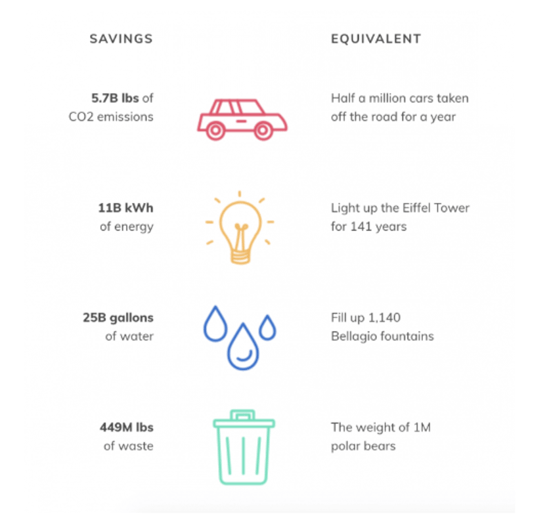Businesses that use their influence for the greater good will continue to succeed, especially in this decade. Starting with eco friendly initiatives is a good way to deliver a strong message. Many eyes are on companies, large and small, to reduce their carbon footprint and help create a more sustainable future for our planet. While a large corporation may have the chance to make an immense impact in the world by eliminating a greater amount of carbon tonnage at once, incorporating an eco friendly culture can have a greater ripple effect by engaging all your employees in the process. Teaching individuals how to reduce their personal carbon footprints can improve your sustainability reach and impact far beyond your company’s individual reach.
1. Sponsor Carpooling, Public Transit and Biking
Promoting programs for employees who help reduce emissions and cut down on congestion from traffic is a great way to help employees lower their carbon emissions and possibly encourage their health. Offer perks for employees who bike and walk to work, because the activity helps improve their physical health and lower CO2. Reimburse employees that take public transit and promote carpooling programs. Develop a work from home program for employees that can do their jobs away from the office and support employees working from home a day or two each week to cut down on environmental emissions.

2. Promote Organic, Vegetarian and Vegan Snacks
The department that eats together, excels together. Food tends to be at the center of most jobs. Encouraging managers to switch from cheap, calorie dense and unhealthy food to organic and plant-based selections will promote a much more sustainable environment and a healthier workforce. A large amount of energy is consumed when processing, transporting, and storing meat. Animal agriculture is also responsible for greenhouse gas emissions, intense water processes, and acres of land for crops. Switching to a meatless menu can improve one’s health and also accidentally helps the environment and our animals!
3. Clothing Drive
You may think your transportation habits are the biggest personal contributor to climate change, but the fashion industry is actually more devastating to the planet than the airline industry. One study found that the manufacturing of textiles—the majority of which goes into clothing—accounts for 1.2 billion tons of greenhouse gas emissions annually, which is more than all international flights and maritime shipping trips combined. Encouraging employees to donate clothing to charities that will sell the used garments can help them reduce their carbon footprint while also helping people in need. Sharing information about how much emissions and water use are required in the manufacturing of new clothing and sharing with employees ways to calculate their closet’s carbon footprint, such as with the Fashion Footprint Calculator by ThredUp, may encourage employees to also shop second hand as well.
4. Set Up a Reuse and Recycle Program
The idea that so many things are easily disposable has created a world culture that throws away items without thinking twice about it. Start changing that thought process with every employee. Set up of recycling program with your facilities management team and clearly communicate the effort. Create SMART goals that can be measured and built upon each year. Set up areas that can also be used for sharing and reuse, like a book-swap library. Make sure you also build the reuse and recycle thought process into work processes. If a product or project doesn’t make the winner’s circle, find ways to revisit it and build upon the initial idea to make it better. When you renovate the office, allow employees to make projects out of the old items or support a local charity with a large donation of furniture.
5. Support Sustainability Workshops
Employees learn how to be more sustainable in many ways. When you support workshops that can teach new and innovative sustainability practices to employees, you’ll be building their knowledge while helping to build a better world. These practices may also inspire innovation into the workplace and influence new ideas and practices on the work floor and in R&D. Start with bringing in green experts to teach employees ways to be more sustainable in their lives, in and out of the office. Employees can also teach each other different ways that they can be more sustainable. Poll employees to see what types of topics they would like more information on. They may want to have workshops on how to thrift shop, ways reuse clothing for other purposes or how to repurpose old fashion and make it new again. They may want to learn about composting, recycling, or how to turn old concert t-shirts into a quilt.
Some employees may be living sustainable lives and not know the impact they are having. Informing employees of their positive impact, even if it’s accidental, and encouraging additional steps, can promote positive movements inhouse and for the world.
Doing something good for the earth is good for everyone. It will also allow you to show and engage customers based on the the positive impact your employees and facilities are having by sharing resources, saving energy and having a green future. Together we have an impact.






Leave a Comment